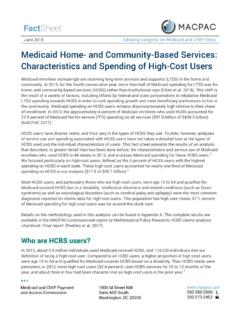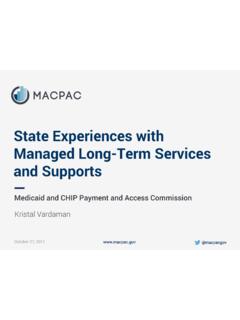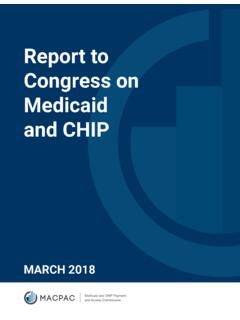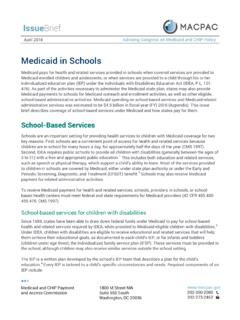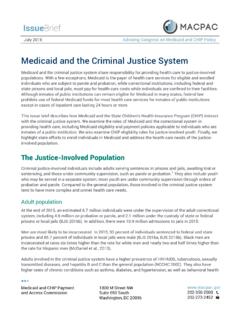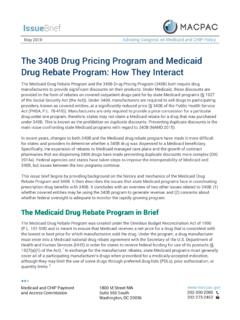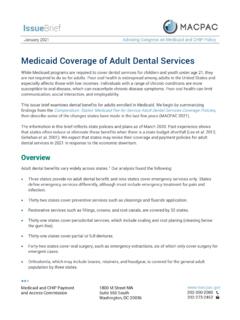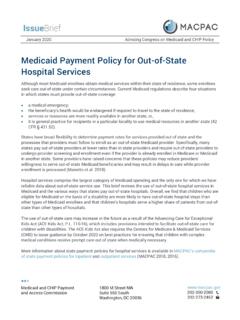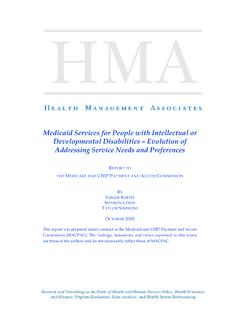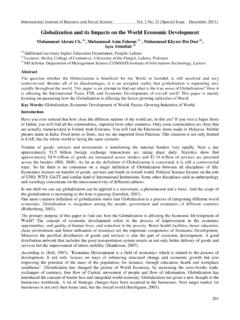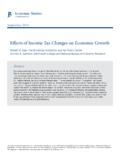Transcription of Medicaid Payment Policy for Federally Qualified Health Centers
1 December 2017 Advising Congress on Medicaid and CHIP Policy Medicaid Payment Policy for Federally Qualified Health Centers State Medicaid programs are required to cover services furnished by Federally Qualified Health Centers (FQHCs), community-based Health care providers that receive federal funds from the Health Resources & Services Administration (HRSA) to provide care in underserved areas. FQHC services must include preventive and primary Health care services such as family and internal medicine, pediatrics, obstetrics and gynecology, diagnostic laboratory and radiology services, emergency services, preventive dental services, and pharmacy services (in certain Centers ). FQHCs may also provide other outpatient services such as vision services, behavioral Health services, and other ambulatory care services included in the state s Medicaid plan.
2 FQHCs also provide some non-medical services, such as language interpretation services and Health education. In fiscal year (FY) 2016, Medicaid spent $ billion for Health center services provided to Medicaid beneficiaries (MACPAC 2017a).1 Medicaid is the largest source of revenue for FQHCs, accounting for about 44 percent nationally in FY 2015 (KFF 2017). In calendar year 2016, nearly half ( percent) of FQHC patients had Medicaid as their primary source of insurance (HRSA 2016).2 This brief describes the methods used to set Medicaid Payment rates for FQHCs, including examples of alternative Payment methods. It also highlights current Policy issues related to Medicaid FQHC Payment . The Role of FQHCs in Medicaid Federally Qualified Health Centers are Health Centers that receive federal grant funding under Section 330 of the Public Health Service These organizations focus on providing comprehensive and affordable primary and preventive Health care to individuals with low-incomes who are uninsured and underinsured, as well as other vulnerable Health Centers target services to fit the needs and priorities of their communities, and often provide services that help their patients access medical care, such as transportation, and language interpretation assistance.
3 5 Nearly 1,400 grantee Health Centers serve more than 25 million patients in over 10,000 delivery sites (HRSA 2017). Consistent with FQHCs mission of serving vulnerable populations, 92 percent of their patients have incomes below 200 percent of the federal poverty level (FPL) (HRSA 2016).6 Close to one-quarter ( percent) of Health center patients identify as African American, and percent identify as Hispanic or Latino (HRSA 2016).7 2 FQHC services FQHCs must provide basic Health services including primary and preventive care, and enabling services to help patients access care such as outreach, transportation, and language interpretation Some Centers also provide physician-administered drugs and outpatient prescription drugs.
4 FQHCs must also provide referrals to off-site specialists including mental Health and substance use disorder providers. Services such as behavioral Health and treatment for substance use disorders, environmental Health , and occupation-related Health services may be provided by an FQHC where appropriate to meet the Health needs of the population served. Section 1905(a)(2) of the Social Security Act (the Act) specifies that state Medicaid programs must cover FQHC services and any other ambulatory services offered by an FQHC and which are otherwise included in the Medicaid state plan. The rationale for this requirement is to ensure that federal grant dollars are used to cover the costs of the uninsured and medically underserved instead of subsidizing costs for the Medicaid population (NACHC 2016a).
5 9 Medicaid Payment for FQHCs Medicaid Payment rules for FQHCs differ from those for other providers because federal law has established a prospective Payment system (PPS) prescribing how FQHCs are to be paid for each encounter or visit. States also may implement an alternative method (APM) that pays the same or more than the federal PPS. Prospective Payment system The Medicare, Medicaid , and SCHIP Benefits Improvement and Protection Act of 2000 ( 106-554) created the PPS for Medicaid FQHC and rural Health clinic (RHC) payments in all states and The State Children s Health Insurance Program (CHIP) was required to adopt this Payment method under the Children s Health Insurance Program Reauthorization Act of 2009 ( 111-3). Prior to the PPS, FQHCs and RHCs were paid based on their costs.
6 FQHC prospective Payment rates are determined based on two key components: PPS base rate: States were required to set a per-visit Payment rate for each FQHC based on the average of the center s costs incurred during fiscal years (FYs) 1999 and FY 2000. The base rate was composed of the allowable capital cost per visit and the lesser of the allowable operating cost per visit or the peer group operating cost ceiling per visit. Payment rates for FQHCs that Qualified for Medicaid payments after FY 2001 are based at either the average of other clinics in the same or adjacent areas or through cost reporting. Adjustments: States use the Medicare economic Index (MEI), a measure of medical practice cost inflation, to adjust Payment rates annually.
7 States are also required to adjust FQHC Payment rates for each clinic to reflect changes in scope of services included in the encounter rate. For example, the 3 state could adjust an FQHC s encounter fee if an FQHC increased its capacity, either by improving facilities, building additional facilities, or providing additional Medicaid -eligible services that were not covered or provided when the base rate was determined. Encounter fees generally cover all Qualified services provided during a visit, unlike a visit in a physician s office in which each service is billed individually. For example, a face-to-face exam with a physician, screening by a nurse, and lab tests that occurred in one visit would all be paid for by the single encounter fee.
8 States can exercise some flexibility within the federal FQHC PPS. For example, states can define which services are included in the encounter or visit, and can establish limits on how many encounters an FQHC can bill per member per day. Hawaii allows FQHCs to bill for one medical or optometry visit, one behavioral Health visit and one dental visit per day, while Oklahoma allows for more than one visit per day within the same category of service as long as it is for an unrelated diagnosis (NACHC 2012). States may also limit the number of reimbursable visits in a year or require prior authorization for visits that exceed the number allowed. In certain situations, FQHCs may file a claim for both a PPS encounter and for additional Medicaid -covered services that are not included in the PPS rate.
9 Some FQHCs may pay for additional or ancillary services using a different methodology. Delaware, for example uses the PPS methodology for primary care costs, a cost-based methodology for administrative costs, and the actual acquisition costs for long-acting reversible contraceptives (CMS 2017). Some states pay the same encounter rate regardless of service type, but others differentiate between medical, behavioral Health , and dental services. Some FQHCs cover services not provided in most physicians offices ( , transportation or other enabling services), so the PPS rate can be higher relative to primary care services provided in a physician s office. Alternative Payment methodology States have the option to use an APM, provided that the Health center agrees to the method and that the alternative method pays at least what the Health center would have received under the If total payments under the APM are less than what would have been paid under the PPS rate, the state must pay the difference to the FQHC.
10 In 2016, states paid more than $536 million in APM supplemental payments, about 12 percent of all Medicaid payments to FQHCs (HRSA 2016, MACPAC 2017b).12 States vary in their use of PPS and APMs. A 2014 survey found that 24 states reported using PPS only, while 14 states used an APM, and 9 states used both (NACHC 2014). States can use multiple APMs within the state, within a Health center for different services, or for services provided by different providers ( , primary care providers, behavioral Health providers, or dentists). In the survey referenced above, among the states that used an APM, most used either a cost-based methodology similar to that used prior to the PPS, or a modified version of the PPS rate that calculates a new base rate by using different base years or an otherwise updated formula (NACHC 2014).
